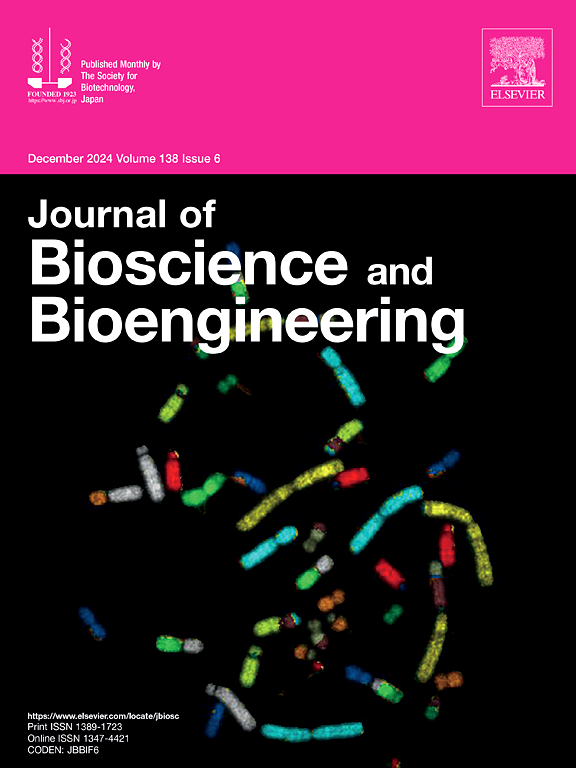Data-independent acquisition-based lipidomics reveals lipidome alterations associated with growth of Saccharomyces cerevisiae at low temperature
IF 2.9
4区 生物学
Q3 BIOTECHNOLOGY & APPLIED MICROBIOLOGY
引用次数: 0
Abstract
Budding yeast, Saccharomyces cerevisiae, adapts to low-temperature stress by altering the amounts and proportions of phospholipids, as well as the structures of acyl chains. To better understand this process, a data-independent acquisition-based lipidomics using liquid chromatography–quadrupole time-of-flight mass spectrometry method was developed to quantify acyl chain isomers in glycerolipids and phospholipids. This method distinguished lipid molecular species, such as phosphatidylcholine (PC) 16:1_18:0 and PC16:0_18:1, at the level of acyl chain isomers. These species were previously identified only at the total acyl chain level as PC 34:1 using the conventional data-dependent acquisition (DDA) method. Using this approach, 145 diacyl lipid molecular species were identified in S. cerevisiae at 30 °C, compared to only 101 identified using the conventional DDA method. Analysis of S. cerevisiae at 10 °C revealed 121 phospholipid and diacylglycerol (DG) molecular species and 260 triacylglycerol (TG) features as well as other 51 sphingolipids and sterol lipids. The results demonstrated unique increases in phosphatidylinositol (PI), phosphatidylethanolamine (PE), monomethyl (MM) PE, and TG containing both 16:1 and medium-chain fatty acids (MCFAs). The knockout strains ole1Δ and slc1Δ, lacking the desaturase that produces 16:1 and the acyltransferase favoring MCFAs, respectively, exhibited growth defects exclusively while growing at 10 °C. These findings suggest that S. cerevisiae regulates its lipid profiles to address low-temperature stress.
基于数据独立获取的脂质组学揭示了脂质组改变与酿酒酵母在低温下的生长有关。
出芽酵母(Saccharomyces cerevisiae)通过改变磷脂的数量和比例以及酰基链的结构来适应低温胁迫。为了更好地理解这一过程,研究人员开发了一种基于数据独立获取的脂质组学,使用液相色谱-四极杆飞行时间质谱法来定量甘油脂和磷脂中的酰基链异构体。该方法在酰基链异构体水平上区分磷脂酰胆碱(PC) 16:1_18:0和PC16:0_18:1等脂类分子种类。这些物种以前仅在总酰基链水平上使用传统的数据依赖获取(DDA)方法鉴定为PC 34:1。利用该方法,在30°C条件下鉴定出酿酒酵母中145种二酰基脂质分子,而传统的DDA方法仅鉴定出101种。在10°C下对酿酒酵母进行分析,发现121种磷脂和二酰基甘油(DG)分子种,260种三酰基甘油(TG)分子种,以及51种鞘脂和甾醇类。结果显示含有16:1和中链脂肪酸(MCFAs)的磷脂酰肌醇(PI)、磷脂酰乙醇胺(PE)、单甲基(MM) PE和TG的独特增加。敲除菌株ole1Δ和slc1Δ分别缺乏产生16:1的去饱和酶和有利于MCFAs的酰基转移酶,在10°C下生长时只表现出生长缺陷。这些发现表明酿酒酵母通过调节其脂质谱来应对低温胁迫。
本文章由计算机程序翻译,如有差异,请以英文原文为准。
求助全文
约1分钟内获得全文
求助全文
来源期刊

Journal of bioscience and bioengineering
生物-生物工程与应用微生物
CiteScore
5.90
自引率
3.60%
发文量
144
审稿时长
51 days
期刊介绍:
The Journal of Bioscience and Bioengineering is a research journal publishing original full-length research papers, reviews, and Letters to the Editor. The Journal is devoted to the advancement and dissemination of knowledge concerning fermentation technology, biochemical engineering, food technology and microbiology.
 求助内容:
求助内容: 应助结果提醒方式:
应助结果提醒方式:


